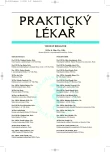Liver abscess in asymptomatic perforating diverticulitis resembling malignant liver tumour
Authors:
I. Hejlová 1; M. Oliverius 2; E. Honsová 4; D. Kautznerová 5; H. Filipová 5; J. Šperl 1
; J. Špičák 1; P. Trunečka 3
Authors‘ workplace:
Klinika hepatogastroenterologie
Přednosta: prof. MUDr. Julius Špičák, CSc.
1; Klinika transplantační chirurgie
Přednosta: prof. MUDr. Miloš Adamec, CSc.
2; Transplantcentrum
Přednosta: MUDr. Pavel Trunečka, CSc.
3; Pracoviště klinické a transplantační patologie
Přednosta: MUDr. Eva Honsová, Ph. D.
4; Pracoviště radiodiagnostiky a intervenční radiologie
Přednosta: doc. MUDr. Jan Peregrin, CSc.
Institut klinické a experimentální medicíny, Praha
Ředitel: doc. MUDr. Jan Malý, CSc.
5
Published in:
Prakt. Lék. 2008; 88(8): 474-477
Category:
Case Report
Overview
Pyogenic liver abscess is a rather uncommon disease with high mortality when untreated. Its most frequent causes are biliary tract diseases, it can also be related to portal bacteriaemia resulting from intraabdominal infection. Therapy of liver abscess includes administration of antibiotics with the addition in larger abscesses of percutaneous drainage. Only in a minority of patients is surgical drainage or resection indicated. We present a patient with a large liver abscess resembling malignant tumour in scans which was caused by asymptomatic perforating diverticulitis. Laparotomy allowed definitive diagnosis and a therapeutic solution consisting of resection of the perforating part of the colon and drainage of the liver abscess.
Keywords:
liver abscess, diverticulitis
Sources
1. Rubin, R.A., Mitchell, D.G. Evaluation of the solid hepatic mass. Med. Clin. North Am. 1996, 80, 5, p. 907-928.
2. Ng, S.S.M., Lee, J.F.Y., Lai, P.B.S. Role and outcome of conventional surgery in the treatment of pyogenic liver abscess in the modern era of minimally invasive therapy. World J. Gastroenterol. 2008, 14, 5, p. 747-751.
3. Pearce, N.W., Knight, R., Irving, H., Menon, K., Prasad, K.R., Pollrad, S.G., Lodge, J.P.A., Toogood, G.J. Non-operative management of pyogenic liver abscess. HPB 2003, 5, 2, p. 91-95.
4. Read, D.R., Hambrick, E. Hepatic abscesses in diverticulitis. South. Med. J. 1980, 73, 7. p. 881-883.
5. Hope, W.W., Vrochides, D.V., Newcomb, W.L., Mayo-Smith, W.W., Iannitti, D.A. Optimal treatment of hepatic abscess. Am. Surg. 2008, 74, 2 . p. 178-182.
6. Chung, Y.F.A., Tan, Y.M., Lui, H.F., Tay, K.H., Lo, R.H.G., Kurup, A., Tan, B.H. Management of pyogenic liver abscesses- percutaneous or open drainage? Singapore Med. J. 2007, 48, 12, p. 1158-1164.
7. Wang, C.L., Guo, X.J, Qiu, S.B., Lei, Y., Yuan, Z.D. Diagnosis of bacterial hepatic absces by CT. Hepatobiliary Pankreat. Dis. Int. 2007 6. 3. p. 271-275.
8. Yoshida, M., Mitsuo, M., Kutsumi, H., Fujita, T., Soga, T., Nishimura, K., Kawabata, K., Kadotani, Y., Kinoshita, Y., Chiba, T., Kuroiwa, N., Fujimoto, S. A succesfully treated case of multiple liver abscesses accompanied by portal venous gas. Am. J. Gastroenterol. 1996, 9, 1, p. 2423-2425.
9. Nishimori, H., Ezoe, E., Ura, H., Imaizumi, H., Meguro, M., Furugata, T., Katsuramaki, T., Hata, F., Yasoshima, T., Hirata, K., Asai, Y. Septic thrombophlebitis of the portal and superior mesenteric veins as a complication of appendicitis: Report of a case. Surg. Today 2004, 34, p. 173-176.
10. Wang, J.T., Zhao, H.Y., Liu, Y.L. Portal vein thrombosis. Hepatobiliary Pankreat. Dis. Int. 2005, 4, 4, p. 515-518.
11. Sogaard, K.K., Astrup, L.B., Vilstrup, H., Gronbaek, H. Portal vein thrombosis; risk factors, clinical presentation and treatment. BMC Gastroenterology 2007, 7, p. 34.
12. Santos, S.A., Alberto, S.C.F., Cruz, E., Pires, E., Figueira, T., Coimbra, E., Esteves, J., Oliveira, M., Novais, L., Deus, J.R. Hepatic abscess induced by foreign body: Case report and literature review. World J. Gastroenterol. 2007, 13, 9, p. 1466-1470.
13. Wallack, M.K., Brown, A.S., Austrian, R., Fitts, W.T. Pyogenic liver abscess secondary to asymptomatic sigmoid diverticulitis. Ann. Surg. 1976, 184, 2, p. 241-243.
14. Liebert, C.W. Hepatic abscess resulting from asymptomatic diverticulitis of the sigmoid colon. South. Med. J. 1981, 74, 1, p. 71-73
15. Tsou, Y.K., Lin, C.J, Liu, N.J., Lin, C.C., Lin, C.H., Lin, S.M. Inflammatory pseudotumor of the liver: Report of eight cases, including three unusual cases, and a literature review. J. Gastroenterol. Hepatol. 2007, 22, p. 2143-2147.
16. Nakama, T., Hayashi, K., Komada, N., Ochiai, T., Hori, T. Inflammatory psedotumor of the liver diagnosed by needle liver biopsy under ultrasonographic tomography guidance. J. Gastroenterol. 2000, 35, p. 641-645.
17. Kim, S.R., Hayashi, Y., Kudo, M., Matsuoka, T., Imoto, S., Sasaki, K., Shintani, S., Song K.B., Park, S.Y., Kim, J.H., Ando, K., Koterazawa, T., Kim, K.I., Ninomiya, T. Inflammatory pseudotumor of the liver in a patient with chronic hepatitic C: Difficulty in differentiating it from hepatocelular carcinoma. Pathology International. 1999, 49, p. 726-730.
18. Akatsu, T., Wakabayashi, G., Tanimoto, A., Kameyama, K., Kitajima, M. Inflammatory psedotumor of the liver masquerading as hepatocellular carcinoma after a hepatitis B virus infection: Report of a case. Surg. Today 2006, 36, p. 1028-1031.
19. Ogawa, T., Yokoi, H., Kawarada, Y. A case of inflammatory pseudotumor of the liver causing elevated serum Ca19-9 levels. Am. J. Gastroenterol. 1998, 93, 12, p. 2551-2555.
Labels
General practitioner for children and adolescents General practitioner for adultsArticle was published in
General Practitioner

2008 Issue 8
- Memantine Eases Daily Life for Patients and Caregivers
- Metamizole vs. Tramadol in Postoperative Analgesia
- Metamizole at a Glance and in Practice – Effective Non-Opioid Analgesic for All Ages
- Memantine in Dementia Therapy – Current Findings and Possible Future Applications
- What Effect Can Be Expected from Limosilactobacillus reuteri in Mucositis and Peri-Implantitis?
Most read in this issue
- Chronic damage of the triangular fibrocartilage complex
- Acute facial palsy – a comparison of clinical and laboratory parameters in patients with Borrelia and idiopathic aetiology
- Stenosis of the left subclavian artery as a cause of angina pectoris progression after CABG: coronary-subclavian steal syndrome
- Acute exacerbation of chronic obstructive pulmonary disease as seen by the intensivist
